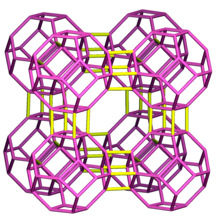

A molecular sieve is a material with pores (molecule-sized holes) of uniform size which link the interior of the solid to its exterior. These materials embody the molecular sieve effect: "With respect to porous solids, the surface associated with pores communicating with the outside space may be called the internal surface. Because the accessibility of pores may depend on the size of the fluid molecules, the extent of the internal surface may depend on the size of the molecules comprising the fluid, and may be different for the various components of a fluid mixture."[1] The specification for the pores is that they not only communicate from the exterior to the interior, but the pores are uniform in size. Many kinds of materials exhibit some molecular sieves, but zeolites dominate the field. Zeolites are almost always aluminosilicates, or variants where some or all of the Si or Al centers are replaced by similarly charged elements.[2]
- ^ "Molecular Sieve Effect". IUPAC GoldBook.
- ^ Cite error: The named reference
Kresgewas invoked but never defined (see the help page).